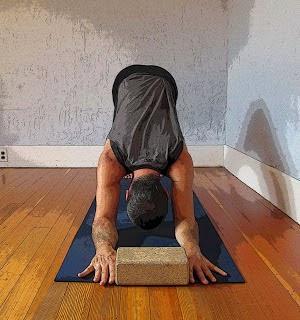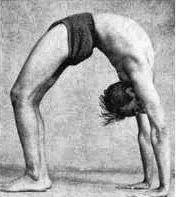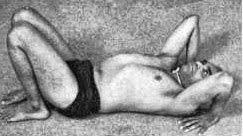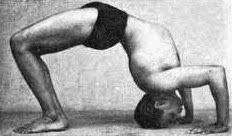B.K.S. Iyengar in Urdva Dhanurasana
Last week in my pose Friday Q&A: Arm Strength and Urdva Dhanurasana, I described the movements of the upper body in the challenging yoga asana Urdhva Dhanurasana, known in English as Upward-Facing Bow pose or Wheel pose. Because our reader was asking us about upper body issues he had as they related to Upward-Facing Bow, my answer about how to get up into the pose really only dealt with a part of the story—maybe not even half the story.In reality, there are two other huge factors in increasing your chances of having success in this pose: 1) utilizing your much stronger lower body to help you up, and 2) adequately preparing parts of your body that need to stretch and open to achieve this unusual, deep backbend shape.Warming Up for Upward-Facing Bow PoseI’ll describe the stretchy, opening stuff you need to look at first, as this is usually what I spend most of my practice doing to prepare for the goal pose of Upward-Facing Bow pose, if I have it in my sequence on a given day. Typically tight places that have to be lengthened in preparation for Upward-Facing Bow pose include:
- the muscles at the front of your upper legs and anterior hip joints
- the front line of your torso and belly
- the action known as flexion of your shoulder joints, where your arms come up along side your head

“One of the reasons people have so much trouble getting up in this pose is because they think it is all about the arms when it is not. If you focus on getting into the pose using your LEGS rather than your arms (although the arms certainly come into play) and lifting your pelvis up first using your legs (which are stronger than your arms), you can lift yourself up in a circular motion which is way less effortful than just by trying to push yourself up with your arms. That’s the way I learned it a long time ago, and have taught it to other people as well, who find it a little revelation.” The way I think about the “circular action” Nina refers to here is that as you press your feet into the floor to initiate the lift of the your, you let your knees move over in the direction of the toes a bit, and, as your hips begin to lift and shift, your arms can more easily press into floor and begin to lift the chest up, too. Seen from the side, it would look like you are circling your body out over the toes before lifting up to the full Wheel. Another suggestion that Nina mentioned and that I utilize as well is using a lift under the pelvis but NOT the rest of the torso to help you start with this action of lifting the pelvis before the shoulders. By using a lift, either a block or bolster, you are just making the amount of lift for your legs and arms a bit less high—every little bit helps.
This circular action works well if you are going straight up into the pose from Constructive Rest pose, as some teachers teach it, or if you are going up in two-phases, first by moving from Constructive Rest into a form of Bridge pose (with the crown of your head on the floor) and then moving from Bridge pose into full Upward-Facing Bow pose. (If you have any neck issues and are not already doing the two-phase movement—or even if you are—please discuss the two-phase technique with your teacher.)
Phase 1
Phase 2
Poses that have the same leg actions as Upward-Facing Bow pose can help strengthen your leg muscles for the entry into the pose. Try moving dynamically in and out of Bridge pose (Setubanda Sarvagasana). You can also practice moving dynamically from Mountain Pose into deeper versions of Utkatasana (Powerful pose) and then back to Mountain—it is the second half of this dynamic sequence that simulates the leg action required to get up into Upward-Facing Bow pose. There are certainly many more ways you could both open and strengthen your body for Upward-Facing Bow pose, but the suggestions here will get you started. And there are also a lot of modified ways of doing the full pose. But for simplicity’s sake, we have kept it pretty straightforward for you today! Remember that this is a challenging pose for many, many yoga practitioners. Approach it respectfully, listen to your body, and don’t rush to perfect it too quickly.Subscribe to YOGA FOR HEALTHY AGING by Email ° FollowYoga for Healthy Agingon Facebook



